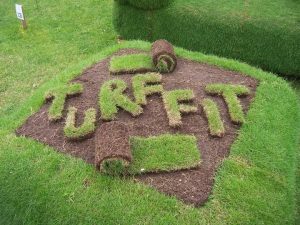Lawn Care and Maintenance
Check out our useful month by month lawn care guide.*
As long-established turf growers and installers we have a wealth of experience in looking after lawns. Follow our monthly lawn care guide for beautiful, lush green lawns. With decades of industry experience under our belt, we’ve honed our skills and perfected our techniques to ensure that every lawn we touch flourishes with lush greenery. And, we are excited to share some of the best practices for lawn care and lawn maintenance with you, empowering you to enjoy a thriving and beautiful lawn all year round.

Monthly Lawn Care Guide
Follow our monthly lawn care guide for beautiful, lush green lawns.
January
- Weather permitting, aerate the surface using a solid tine spiking machine or garden fork.
- Keep surface free from leaves, twigs and debris reducing the risk of disease.
- Maintain a mowing height of between 12mm and 25mm
February
- Cut straggly grass with carefully set mowers and dispose of the clippings at the same time.
- Then you need to brush the ground regularly if it’s dry to remove debris if mowing has been prevented due to ground conditions.
- Prepare for Spring renovation now!
March
- Cut straggly grass with carefully set mower, collecting the grass clippings.
- Brush ground regularly if dry to remove debris.
- At sign of growth, roll surface with light-to-medium weight garden roller and brush the surface to remove debris.
- Mow grass, start reducing mowing height gradually (do not remove more than 25%) Always use a grass box. A two-directional 50/50 mowing is best at first. Make sure the mower is set correctly to achieve a clean cut.
- Two days after first mowing apply organic fertiliser designed for spring/summer application. We can supply our specially formulated product. If no rain within three days of application, water fertiliser into topsoil.
April
- Make an application of lawn fertiliser mid-month. Visit our online shop for fertiliser.
- Consider applying a selective weed killer to broadleaved weeds if required.
- Apply moss killer if needed. Sulphate of Iron is useful to control moss, invigorate desirable grasses and deepen the green colour of overall appearance.
- Gradually reduce mowing height and step up mowing frequency to twice weekly. Always remove clippings.
May
- Scarify area, rake to remove dead grass lying in the base of sward or thatch.
- If a large quantity of material is removed at first pass, scarify every two-to-three weeks during the growing season, until only a small amount of debris is removed.
- If grass is sparse in areas, apply new grass seed mixture by hand or machine, at the rate of approximately 25 grams per square metre.
- Apply quality topsoil brushed into surface of sward, effectively covering the seeds, approximately 900 kilos (1 bag) per 50 square metre garden.
- Continue mowing 2-3 times per week and aim to be at an optimum mowing height between 23mm to 37mm.
- Continue routine rolling.
- Apply lawn fertiliser.
June
- Should there be any signs of drought such as a slightly blue colour to the grass leaf, or worse, a light brown colour, water needs to be applied to the lawn area.
- Avoid excessive watering since this encourages weed grasses to flourish.
- If other weeds are present a further treatment of selective herbicide (weed killer) will be necessary.
- Continue to mow ensuring all clippings are removed and disposed of or kept for compost.
- Verticut or lightly scarify once in a while to lift any lateral grass growth, this will also aerate the bottom of the sward of grass.
- Apply lawn fertiliser if the grass is looking stressed or weak.
July/August
- Continue regular mowing and aim to be at an optimum mowing height of between 25mm to 37mm.
- Mow in alternate directions periodically and compost any grass clippings or use them as mulch.
- Water during drought and if the area has become compacted a light spiking can be beneficial to relieve any hardness and oxygenate the soil, encouraging new growth at the same time.
- Watering afterwards will get the water to where the turf needs it most preventing too much evaporation and saving valuable resources.
- Apply lawn fertiliser if the grass is looking hungry or anaemic, use an appropriate lawn applicator.
- Above all, you should take the opportunity to enjoy your lawn. There will be plenty of time to renovate any worn areas in the next couple of months.
September
- Decrease the frequency of mowing.
- Gradually raise the height of cut to between 6mm and 12mm above the summer height.
- Hollow tine spike or use a fork if the ground feels too firm, follow by incorporating quality topsoil or another suitable top dressing.
- Once the bulk top dressing has been applied, brush or work it into the sward until an even coverage has been produced. Ensure there are no areas that have been completely smothered.
- Incorporate a quality seed mixture compatible with the grasses contained in your lawn.
- Ground temperature in September should allow seed to germinate.
- Water if necessary and lightly roll in good weather.
October
- Regular mowing gradually comes to an end but your lawn might need an occasional trim. Ensure no more than 25% of the growth is removed at once.
- ‘Rest’ for your lawn in readiness for winter months and apply a solution of sulphate of iron to enhance the appearance of grass and harden off for winter.
November
- During frost-free and dry periods occasional mowing when necessary. The height of cut at this time should be raised to between 12mm and 25mm.
December
- Keep area brushed and rake free from debris. This is especially important after strong winds.
- Remember to keep off the grass turf during wet and frosty weather
We trust you have found our monthly lawn care guide useful, but if you have any further queries do not hesitate to call us on 01592 869000
*These instructions are of an advisory nature and are not compulsory.


